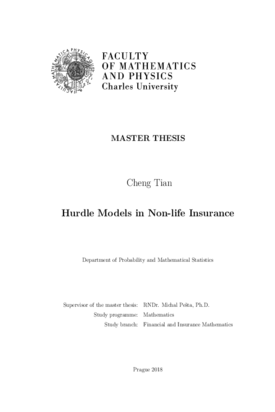Hurdle models in non-life insurance
Překážkové modely v neživotním pojištění
diplomová práce (OBHÁJENO)

Zobrazit/
Trvalý odkaz
http://hdl.handle.net/20.500.11956/94848Identifikátory
SIS: 188550
Kolekce
- Kvalifikační práce [11238]
Autor
Vedoucí práce
Oponent práce
Branda, Martin
Fakulta / součást
Matematicko-fyzikální fakulta
Obor
Finanční a pojistná matematika
Katedra / ústav / klinika
Katedra pravděpodobnosti a matematické statistiky
Datum obhajoby
31. 1. 2018
Nakladatel
Univerzita Karlova, Matematicko-fyzikální fakultaJazyk
Angličtina
Známka
Dobře
Klíčová slova (česky)
překážkový model, neživotní pojištění, logistická regrese, semikontinuální dataKlíčová slova (anglicky)
hurdle model, non-life insurance, logistic regression, semi-continuous dataA number of articles only present hurdle models for count data. we are motivated to present hurdle models for semi-continuous data. Because semi- continuous data is also commonly seen in non-life insurance. The thesis deals with the parameterization of various hurdle models for semi-continuous data besides for count data in non-life insurance. Two components of a hurdle model are modeled separately. A hurdle component is modeled by a logistic regression. For a semi-continuous data, a continuous component is modeled by several various regressions. Parameters of each component are estimated through maximum likelihood estimation. Model selection is mentioned before theoretical approaches are applied on the vehicle insurance data. Finally, we get some predicted values based on the fitted models. The prediction gives insurance companies a general idea on setting premium but not accurate. 1
A number of articles only present hurdle models for count data. we are motivated to present hurdle models for semi-continuous data. Because semi- continuous data is also commonly seen in non-life insurance. The thesis deals with the parameterization of various hurdle models for semi-continuous data besides for count data in non-life insurance. Two components of a hurdle model are modeled separately. A hurdle component is modeled by a logistic regression. For a semi-continuous data, a continuous component is modeled by several various regressions. Parameters of each component are estimated through maximum likelihood estimation. Model selection is mentioned before theoretical approaches are applied on the vehicle insurance data. Finally, we get some predicted values based on the fitted models. The prediction gives insurance companies a general idea on setting premium but not accurate. 1
